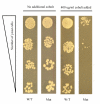Colony size measurement of the yeast gene deletion strains for functional genomics
- PMID: 17408490
- PMCID: PMC1854909
- DOI: 10.1186/1471-2105-8-117
Colony size measurement of the yeast gene deletion strains for functional genomics
Abstract
Background: Numerous functional genomics approaches have been developed to study the model organism yeast, Saccharomyces cerevisiae, with the aim of systematically understanding the biology of the cell. Some of these techniques are based on yeast growth differences under different conditions, such as those generated by gene mutations, chemicals or both. Manual inspection of the yeast colonies that are grown under different conditions is often used as a method to detect such growth differences.
Results: Here, we developed a computerized image analysis system called Growth Detector (GD), to automatically acquire quantitative and comparative information for yeast colony growth. GD offers great convenience and accuracy over the currently used manual growth measurement method. It distinguishes true yeast colonies in a digital image and provides an accurate coordinate oriented map of the colony areas. Some post-processing calculations are also conducted. Using GD, we successfully detected a genetic linkage between the molecular activity of the plant-derived antifungal compound berberine and gene expression components, among other cellular processes. A novel association for the yeast mek1 gene with DNA damage repair was also identified by GD and confirmed by a plasmid repair assay. The results demonstrate the usefulness of GD for yeast functional genomics research.
Conclusion: GD offers significant improvement over the manual inspection method to detect relative yeast colony size differences. The speed and accuracy associated with GD makes it an ideal choice for large-scale functional genomics investigations.
Figures






References
-
- Castrillo JI, Oliver SG. Yeast as a touchstone in post-genomic research: strategies for integrative analysis in functional genomics. J Biochem Mol Biol. 2004;37:93–106. - PubMed
Publication types
MeSH terms
Substances
LinkOut - more resources
Full Text Sources
Molecular Biology Databases
Miscellaneous

